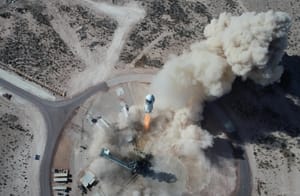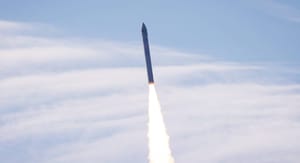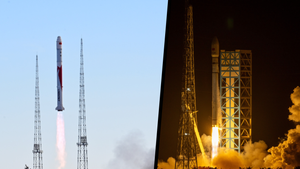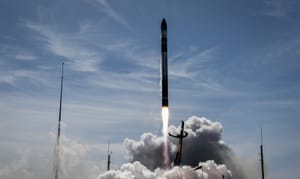
Dec 21, 2023
New Shepard returns to flight with the NS-24 Mission
On the 19th of December, Blue Origin's New Shepard vehicle returned to flight after a fifteen-month hiatus from flight. This flight flew without a crew but did carry research payloads and science experiments. According the Blue Origin, the payloads from the failed NS-23 mission were reflown on this flight.
New Shepard booster No. 4 lifted off for the ninth time from Blue Origin's Launch Site One, in Western Texas, and flew to an altitude of 350,885 feet above sea level before landing on a landing pad near its launch pad.
The capsule believed to be flying atop of the booster was RSS H.G. Wells. The capsule traveled to an altitude of 351,248 feet above sea level before touching down in the Western Texas desert under parachute near its launch site.
Both vehicles passed the Kármán line and reached space.

The NS-24 carried thirty-three payloads, according to Blue Origin's post-flight press release, from commercial companies, NASA, research institutions, and academia. New Shepard also flew thirty-eight thousand postcards from the Club for the Future as part of the non-profit's Postcards to Space program.
In the post-flight press release Phil Joyce, Senior Vice President of the New Shepard program, said the following about the flight:
“A special thank you to all of our customers who flew important science today and the students who contributed postcards to advance our future of living and working in space for the benefit of Earth,” – “Demand for New Shepard flights continues to grow and we’re looking forward to increasing our flight cadence in 2024.”

What caused the failure of the NS-23 mission?
Back on the 12th of September 2022, the capsule, also RSS H.G. Wells, atop of New Shepard booster No. 3 activated its launch escape system one-mintue and five seconds into flight.

In a post-flight investigation press release on the 24th of March 2023, Blue Origin stated the reason for the failure of the mission was as follows:
"The direct cause of the NS-23 mishap was a thermo-structural failure of the engine nozzle. The resulting thrust misalignment properly triggered the Crew Capsule escape system, which functioned as designed throughout the flight."
The 'thermo-structural failure' led to the vehicle to command a shutdown of the BE-3 engine leaving the vehicle unpowered. The booster was not commanded to be destroyed in flight due to posing no threat to people or property.
The NS-23 mission ended with the capsule landing earlier than expected and the destruction of New Shepard booster No. 3.
What is New Shepard?
New Shepard is a single-stage reusable sub-orbital launch vehicle flown and manufactured by American aerospace company Blue Origin. New Shepard commonly flies tourists and microgravity science missions.
The capsule of New Shepard can carry either six passengers or an undisclosed mass of science experiments. The capsule also has an abort motor in the event of failure during the boosters phase of flight.
The booster of New Shepard is powered by one BE-3 engine generating a believed 50 tons of thrust burning liquid hydrogen and liquid oxygen for up to two-minutes and twenty-one seconds. The BE-3 engine is capable of restarting in-flight enabling the booster to be recovered and reused. New Shepard's booster also has numerous aerodynamic surfaces to allow the booster to guide itself during unpowered flight.

Who is Blue Origin?
Blue Origin is an American aerospace company founded in September of 2000 and headquartered in Kent, Washington, in the United States. The company currently operates the New Shepard sub-orbital reusable launch vehicle and is developing the heavy-lift partially reusable orbital launch vehicle called New Glenn.
Blue Origin was founded, and is still owned, by Jeff Bezos with the following long-term vision:
"Blue Origin was founded with a vision of millions of people living and working in space for the benefit of Earth. Blue Origin envisions a time when people can tap into the limitless resources of space and enable the movement of damaging industries into space to preserve Earth, humanity’s blue origin."




